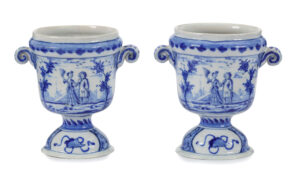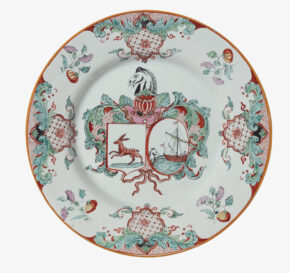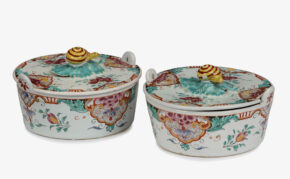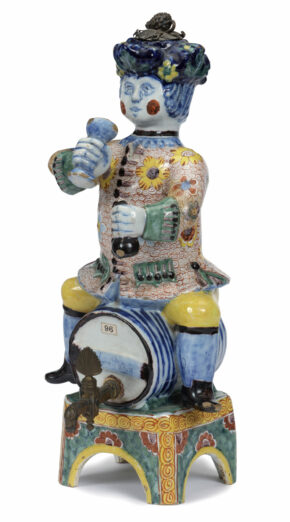![]()
Images on this website are licensed under a
Creative Commons Attribution-NoDerivs 3.0 Unported License.
OBJECT
•D2444. Exceptional Pair of Polychrome Prancing and Flehming Horses
Delft, circa 1765
Marked lpk in blue for De Porceleyne Lampetkan (The Porcelain Ewer) factory from 1609 until 1811
Each horse, both stallions, with blue eyes, manes and tail, manganese ears and hooves, covered by a decorative blue fringed and tasseled openwork blanket, trimmed with a yellow and iron red fringe band and at the manes and tail a yellow and iron-red rosette, the yellow bridle fringed with an iron-red band, underneath the yellow and iron-red shell shaped saddle a saddle blanket with blue dots and polychrome floral motifs, the prancing stallions standing on their hind legs on a green rectangular base with a red and green edge, the tales attached to the base for stability.
DIMENSIONS
Height: 23.5 cm. (9.3 in.)
PROVENANCE
By repute Collection Jacques Couque, Paris;
J.M. Béalu & Fils at the Paris Biennale, 1994 or 1996;
French Private Collection, Paris, 2023 (Provenance+)
NOTE
Horses have forged a unique and enduring connecting with humans due to their remarkable blend of intelligence, elegance, and strength. Initially hunted, the horse earned admiration, prompting humans to recognize their utility. Over time, horses became invaluable as diligent workers, a source of pleasure in sports, and even as captivating performers in shows. These qualities rendered them a cherished subject in art, and also in Delft.
From 1700, the Delft potters started to experiment with molds for modeling. This led to the production of a multitude of rond de bosse figurines. The naturalistic animal figures were inspired from the porcelain and faience centers of Strasbourg, Meissen, Chantilly, etc. This pair of horses was probably intended as ornaments to be displayed in glass cabinets or etageres.
This pair of horses exhibits a unique behavior rarely seen among Delft horse figurines: the phenomenon of ‘flehming’. Flehming involves neck extension, head elevation, and inhalation, accompanied by the lifting of the upper lip to expose the horse’s front teeth. This behavior is primarily observed in stallions and is triggered by stimulation of the vomeronasal organ, a specialized structure within the horse. This organ facilitates the transmission of olfactory cues to the brain, initiated when the horse encounters intriguing scents.
SIMILAR EXAMPLES
A similar singular (left) horse seems to have been in the collection of S. Nijstad Oude Kunst. Three pairs of jumping polychrome horses exhibiting this distinctive behavior are known. One pair is housed in the Rijksmuseum Amsterdam (inv. no. BK- NM-12400-246), while the other pair is part of the Lavino Collection at Kunstmuseum, The Hague (inv. no. 1059940), another pair is part of a Belgian private collection. Additionally, there is a pair of white Delft horses from the collection of the Twents Museum, Enschede, on loan from Oudheidkamer Riessen (inv. no. BR0001 (R266) w). While the models share a similar structure, depicting horses leaping over a fence, there are noticeable differences. The tails are shorter or absent, and the pair in the Rijksmuseum Amsterdam even features a plume mounted on the horses’ head. The present pair is the only known example modeled without a fence, which adds to its complexity and makes it more challenging to create due to a lack of stability.









